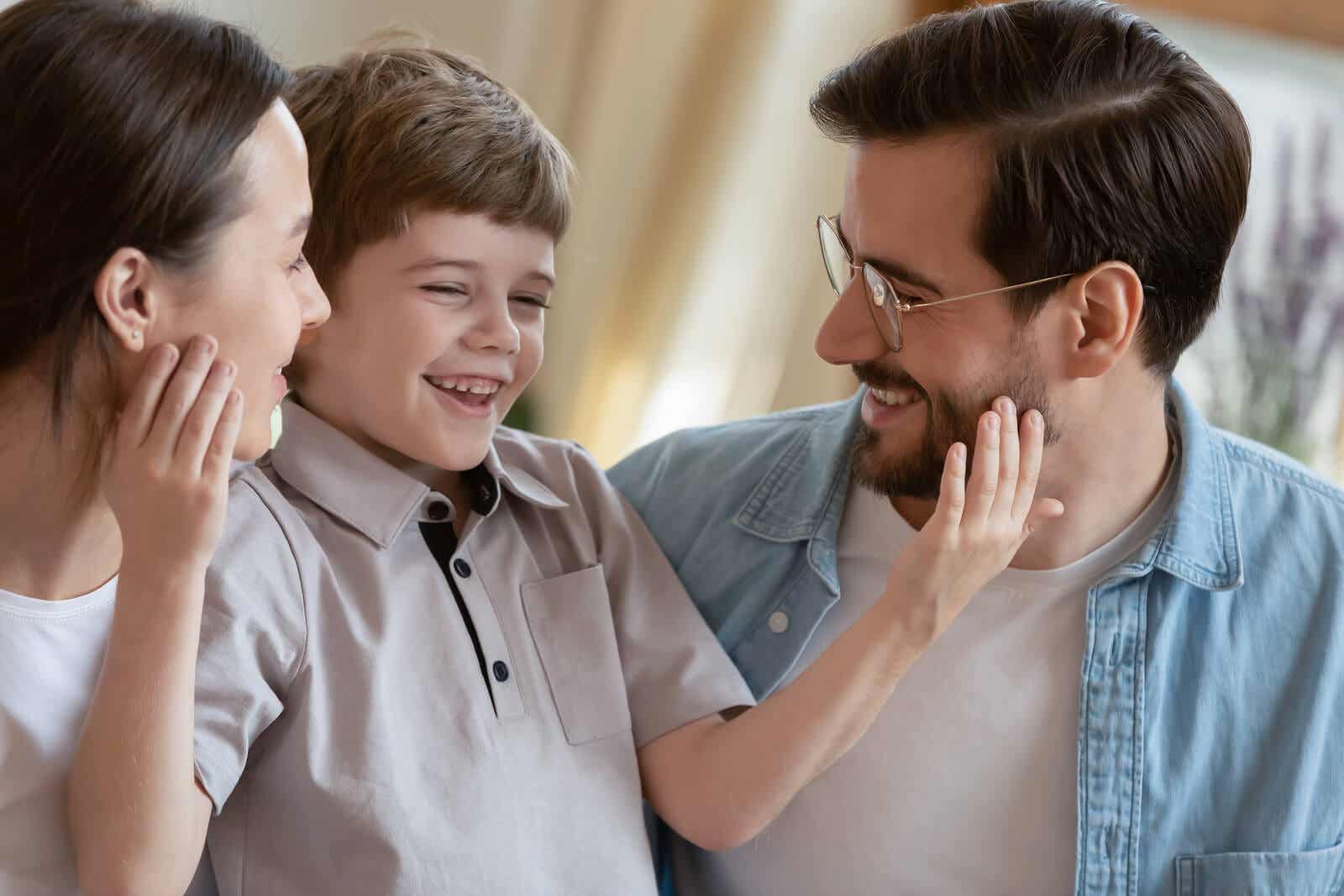6 Simple Ways to Teach Gratitude to your Children

Teaching children about gratitude is crucial in order for them to develop both empathy and respect for others. It’s also a key factor for them to learn the value of everything around them. There are plenty of strategies that you can use to teach gratitude to your children.
While manners, in general, are important, learning to say thank you is critical to fostering the development of other values such as respect, empathy, and self-esteem.
In fact, a study reported in the Journal of Happiness Studies found that gratitude is related to children’s happiness from as early as five years of age. In addition to that, it has also been linked to other individual and social benefits. Would you like to get to know more about it? Discover 6 ways to cultivate this value today!
How can you teach gratitude to your children? 6 great tips
Gratitude is considered one of the healthiest emotions for everyone, regardless of their age. It doesn’t only help in communication with others – it can also increase life satisfaction, improve self-control, strengthen patience, and minimize other negative emotions such as envy and depression.

In general, grateful children have an easier time relating to others, and they usually face situations with optimism and deal well with stress. However, even though this emotion may seem to be innate within us, in reality, it must be taught by example and through small, but meaningful, actions.
1. Teach gratitude to your children by saying thank you with flowers
This gesture is a very special one for small children. If you encourage your child to say thank you with flowers, you can teach them that the other person deserves special treatment for having been kind to them, for sharing something special with them, or simply for their friendship.
The idea here is that you expand the concept of gratitude in your child, and that they learn that they don’t only need to say thank you for material things, but also for those little acts of kindness that they’ve received.
At the same time, you should remind them that when they thank the other person, they shouldn’t expect anything in return.
2. A gratitude jar
This simple resource is one of the nicest ones of all when it comes to teaching children about gratitude. How does it work? Easy! First of all, encourage your child to decorate a jar or a bottle. Then, every day, on small pieces of paper, both of you can write down the things you’re grateful for, and then you simply put them in the bottle.
Finally, at the end of the week, take a few minutes to read all the thank you notes. At that time, you can take the opportunity to teach them more about gratitude and how they can apply it in other settings.
3. A gratitude tree
The gratitude tree works in a similar way to the previous idea. However, in this case, you’ll make a tree and place it on card or recycled materials. Your child needs to cut out and color the leaves or fruits of the tree. Then, on each one, they simply write the things that they’re grateful for.
4. Teach gratitude to your children with thank you cards
Cardboard, colored paper, pencils, stickers…there are endless materials you can give to your children to help them make beautiful thank you cards. The first thing to do is to encourage them to think about the people who have helped them and how they did it.
After that, you can help them look for ideas to make their cards. Finally, take them out to deliver their cards!

5. Gratitude journal
If your children already know how to write, then a gratitude journal is ideal for cultivating this emotion. Writing is a very useful activity, as it promotes reflection, optimizes the child’s thought process, and helps them to express their ideas.
As a result, when children document the things they’re grateful for, it increases their awareness of just how valuable everything they have really is.
6. Reading fables and stories
Many good fables and stories teach children important values, such as respect, empathy, and gratitude. They can communicate positive messages in very exciting ways for your children.
You’ll be able to find many stories online that you can use to teach about gratitude in a clear and entertaining way.
Are you encouraging gratitude in your children?
As you’ll have seen, there are many interesting ways to teach gratitude to your children. You can even start applying them from their first years of life.
The most important thing here is to teach them consistently, both with actions, words and by example. We can’t emphasize enough that it’s one of the most important emotions for a child’s development and well-being.
Bibliography
- Nguyen, S.P., Gordon, C.L. The Relationship Between Gratitude and Happiness in Young Children. J Happiness Stud 21, 2773–2787 (2020). https://doi.org/10.1007/s10902-019-00188-6
- Froh, J. J., Sefick, W. J., & Emmons, R. A. (2008). Counting blessings in early adolescents: An experimental study of gratitude and subjective well-being. Journal of School Psychology, 46(2), 213–233. https://doi.org/10.1016/j.jsp.2007.03.005
Teaching children about gratitude is crucial in order for them to develop both empathy and respect for others. It’s also a key factor for them to learn the value of everything around them. There are plenty of strategies that you can use to teach gratitude to your children.
While manners, in general, are important, learning to say thank you is critical to fostering the development of other values such as respect, empathy, and self-esteem.
In fact, a study reported in the Journal of Happiness Studies found that gratitude is related to children’s happiness from as early as five years of age. In addition to that, it has also been linked to other individual and social benefits. Would you like to get to know more about it? Discover 6 ways to cultivate this value today!
How can you teach gratitude to your children? 6 great tips
Gratitude is considered one of the healthiest emotions for everyone, regardless of their age. It doesn’t only help in communication with others – it can also increase life satisfaction, improve self-control, strengthen patience, and minimize other negative emotions such as envy and depression.

In general, grateful children have an easier time relating to others, and they usually face situations with optimism and deal well with stress. However, even though this emotion may seem to be innate within us, in reality, it must be taught by example and through small, but meaningful, actions.
1. Teach gratitude to your children by saying thank you with flowers
This gesture is a very special one for small children. If you encourage your child to say thank you with flowers, you can teach them that the other person deserves special treatment for having been kind to them, for sharing something special with them, or simply for their friendship.
The idea here is that you expand the concept of gratitude in your child, and that they learn that they don’t only need to say thank you for material things, but also for those little acts of kindness that they’ve received.
At the same time, you should remind them that when they thank the other person, they shouldn’t expect anything in return.
2. A gratitude jar
This simple resource is one of the nicest ones of all when it comes to teaching children about gratitude. How does it work? Easy! First of all, encourage your child to decorate a jar or a bottle. Then, every day, on small pieces of paper, both of you can write down the things you’re grateful for, and then you simply put them in the bottle.
Finally, at the end of the week, take a few minutes to read all the thank you notes. At that time, you can take the opportunity to teach them more about gratitude and how they can apply it in other settings.
3. A gratitude tree
The gratitude tree works in a similar way to the previous idea. However, in this case, you’ll make a tree and place it on card or recycled materials. Your child needs to cut out and color the leaves or fruits of the tree. Then, on each one, they simply write the things that they’re grateful for.
4. Teach gratitude to your children with thank you cards
Cardboard, colored paper, pencils, stickers…there are endless materials you can give to your children to help them make beautiful thank you cards. The first thing to do is to encourage them to think about the people who have helped them and how they did it.
After that, you can help them look for ideas to make their cards. Finally, take them out to deliver their cards!

5. Gratitude journal
If your children already know how to write, then a gratitude journal is ideal for cultivating this emotion. Writing is a very useful activity, as it promotes reflection, optimizes the child’s thought process, and helps them to express their ideas.
As a result, when children document the things they’re grateful for, it increases their awareness of just how valuable everything they have really is.
6. Reading fables and stories
Many good fables and stories teach children important values, such as respect, empathy, and gratitude. They can communicate positive messages in very exciting ways for your children.
You’ll be able to find many stories online that you can use to teach about gratitude in a clear and entertaining way.
Are you encouraging gratitude in your children?
As you’ll have seen, there are many interesting ways to teach gratitude to your children. You can even start applying them from their first years of life.
The most important thing here is to teach them consistently, both with actions, words and by example. We can’t emphasize enough that it’s one of the most important emotions for a child’s development and well-being.
Bibliography
- Nguyen, S.P., Gordon, C.L. The Relationship Between Gratitude and Happiness in Young Children. J Happiness Stud 21, 2773–2787 (2020). https://doi.org/10.1007/s10902-019-00188-6
- Froh, J. J., Sefick, W. J., & Emmons, R. A. (2008). Counting blessings in early adolescents: An experimental study of gratitude and subjective well-being. Journal of School Psychology, 46(2), 213–233. https://doi.org/10.1016/j.jsp.2007.03.005
This text is provided for informational purposes only and does not replace consultation with a professional. If in doubt, consult your specialist.








